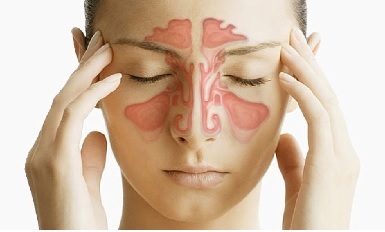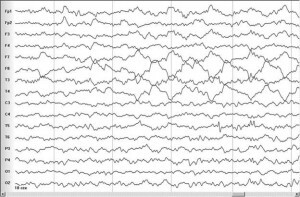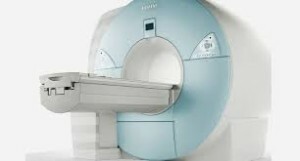Causes of headache in colds and infectious diseases
Contents:
- Diarrhea and discomfort in the head
- Why does my head hurt with flu and SARS?
- Secondary factors that cause pain
 The presence of a headache in the patient may indicate a pathology of the brain or be a secondary manifestation and signal the damage of other organs and systems. Consider the nature of pain manifestations in infections, diseases of the ear and lungs. Let's try to understand the mechanism, why there is a severe headache with a cold?
The presence of a headache in the patient may indicate a pathology of the brain or be a secondary manifestation and signal the damage of other organs and systems. Consider the nature of pain manifestations in infections, diseases of the ear and lungs. Let's try to understand the mechanism, why there is a severe headache with a cold?
Diarrhea and discomfort in the head
After a common cold or transferred SARS, complications can occur - sinusitis. Localization of the lesions distinguish sinusitis, frontal, etmoiditis and sphenoiditis. An unchanged symptom of the presence of an inflammatory process is a headache with sinusitis. The first place in the number of cases and unpleasant consequences is sinusitis.
The defeat of the maxillary sinuses, the accumulation of purulent discharge and as a consequence, the headache in sinusitis - the symptoms that signal a health hazard. To reveal the development of the pathological process will help the manifestations:
- pain in the head, intensifying when turning the head or bending forward;
- hypersensitivity of the face and swelling of the eyes;
- tooth discomfort when leaving a warm room in cold weather;
- fever and chills;
- the presence of purulent discharge from the nasal passages and difficulties with the recognition of odors.
In this case, intense sharp head pains occur in the morning due to pressure in the nasal sinuses and stagnation, they grow until evening and spread to the nape.
In contrast to migraine, pain in the maxillary sinusitis is located in the maxillary sinus and "moves" deep into the head, increases mainly with tilting and does not depend on the intake of certain products. Migraine pain has a direction from the brain to the orbit, increases from the slightest movements and is provoked by nutritional factors.
Why does my head hurt with flu and SARS?
Headache with influenza has several pathogenetic factors:
- increases intracranial pressure due to increased temperature and vasodilation;
- intoxication by the products of the vital activity of viruses and possible brain edema;
- strains the neck muscles from a constant sneezing and runny nose.
It is characterized by a pressing character of pronounced or moderate intensity, it is constantly noted, it intensifies under bright light and is accompanied by lacrimation. The pain is localized at the temples, superciliary areas and orbits. A characteristic feature of the flu is the high temperature for 3 days.
Headache in ARVI occurs for the same reasons as the flu. Since the influence of respiratory pathogens is less aggressive than with influenza, the manifestation of intoxication and temperature levels is much lower, it is not accompanied by cerebral edema, the pain can not be manifested so intensely.
Headache in pneumonia has similar causes for influenza and ARVI.Infectious agents( bacteria and viruses) cause intoxication, a rise in temperature affects the cardiovascular system, raising pressure levels, and a persistent cough provokes headache. Its intensity depends on the severity of the patient's condition, concomitant pathology and timeliness of treatment.
Secondary factors that cause pain
 Headache with coughing occurs due to a number of reasons:
Headache with coughing occurs due to a number of reasons:
- hypertension with prolonged smoking;
- oxygen deficiency in bronchial asthma;
- as a reaction to foreign allergens in allergic people and weather changes in weather-dependent patients;
- of brain pathology in the Arnold-Chiari syndrome;
- intoxication with infectious and colds.
Headache is quite intense, lasting several seconds, covering one part or the entire surface of the head and is more common in men older than 40 years. Concomitant symptoms are general weakness, decreased performance and increased fever.
Its increase in coughing can signal increased blood pressure inside the skull and serious damage - neoplasms and cysts of the brain. The localization of pain is fuzzy, more pronounced in the forehead and is accompanied by nausea or vomiting, a decrease in visual quality.
Headache in hypothermia is associated with the development of cervical myoglosis. At the same time, blood circulation in the skin and muscles is disrupted with vasospasm, tension and consolidation of muscle fibers occur and lactic acid accumulates, the skin becomes red and the pain receptors become irritated. Patients have occipital pain, fever, dizziness, movement becomes limited.
Headache with otitis occurs as a reaction to inflammation, swelling, increased blood pressure and violation of air exchange in the auditory tube. Predominantly it is localized on the one hand, acute with increasing strength, extends to the temple and the frontal part. The spectrum of characteristics is diverse - pulsating, drilling, stabbing, shooting and unbearable.
Thus, due to complaints of discomfort and head pain, it is possible to recognize the disease, to conduct examination and treatment.
write the question in the form below:



